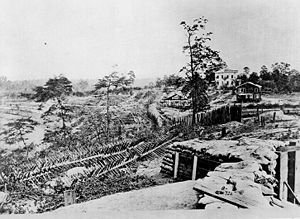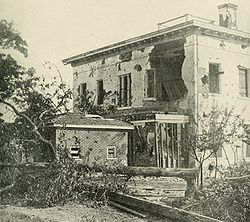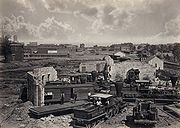
Atlanta in the Civil War
Encyclopedia

Atlanta, Georgia
Atlanta is the capital and most populous city in the U.S. state of Georgia. According to the 2010 census, Atlanta's population is 420,003. Atlanta is the cultural and economic center of the Atlanta metropolitan area, which is home to 5,268,860 people and is the ninth largest metropolitan area in...
, was an important rail and commercial center during the American Civil War
American Civil War
The American Civil War was a civil war fought in the United States of America. In response to the election of Abraham Lincoln as President of the United States, 11 southern slave states declared their secession from the United States and formed the Confederate States of America ; the other 25...
. Although relatively small in population, the city became a critical point of contention during the Atlanta Campaign
Atlanta Campaign
The Atlanta Campaign was a series of battles fought in the Western Theater of the American Civil War throughout northwest Georgia and the area around Atlanta during the summer of 1864. Union Maj. Gen. William T. Sherman invaded Georgia from the vicinity of Chattanooga, Tennessee, beginning in May...
in 1864 when a powerful Union army
Union Army
The Union Army was the land force that fought for the Union during the American Civil War. It was also known as the Federal Army, the U.S. Army, the Northern Army and the National Army...
approached from Federally-held Tennessee
Tennessee
Tennessee is a U.S. state located in the Southeastern United States. It has a population of 6,346,105, making it the nation's 17th-largest state by population, and covers , making it the 36th-largest by total land area...
. The fall of Atlanta was a critical point in the Civil War, giving the North
Union (American Civil War)
During the American Civil War, the Union was a name used to refer to the federal government of the United States, which was supported by the twenty free states and five border slave states. It was opposed by 11 southern slave states that had declared a secession to join together to form the...
more confidence, and (along with the victories at Mobile Bay
Battle of Mobile Bay
The Battle of Mobile Bay of August 5, 1864, was an engagement of the American Civil War in which a Federal fleet commanded by Rear Adm. David G. Farragut, assisted by a contingent of soldiers, attacked a smaller Confederate fleet led by Adm...
and Winchester
Battle of Opequon
The Battle of Opequon, more commonly known as the Third Battle of Winchester, was fought in Winchester, Virginia, on September 19, 1864, during the Valley Campaigns of 1864 in the American Civil War....
) leading to the re-election of President
President of the United States
The President of the United States of America is the head of state and head of government of the United States. The president leads the executive branch of the federal government and is the commander-in-chief of the United States Armed Forces....
Abraham Lincoln
Abraham Lincoln
Abraham Lincoln was the 16th President of the United States, serving from March 1861 until his assassination in April 1865. He successfully led his country through a great constitutional, military and moral crisis – the American Civil War – preserving the Union, while ending slavery, and...
and the eventual surrender of the Confederacy.
Early war years
In the years before the Civil War, Atlanta was a relatively small city, ranking 99th in the United StatesUnited States
The United States of America is a federal constitutional republic comprising fifty states and a federal district...
in size with a population of 9,554 according to the 1860 United States (U.S.) Census. However, it was the 12th-largest city in what became the Confederate States of America
Confederate States of America
The Confederate States of America was a government set up from 1861 to 1865 by 11 Southern slave states of the United States of America that had declared their secession from the U.S...
.
The city was a vital transportation and logistics center, with several major railroads in the area, including the Western & Atlantic Railroad, which connected the city with Chattanooga, Tennessee
Chattanooga, Tennessee
Chattanooga is the fourth-largest city in the US state of Tennessee , with a population of 169,887. It is the seat of Hamilton County...
, 138 miles to the north. A series of roads radiated out from the city in all directions, connecting Atlanta with neighboring towns and states.
Thought to be relatively safe from Union forces early in the war, Atlanta rapidly became a concentration point for the Confederate quartermasters and logistics experts; warehouses were filled with food, forage, supplies, ammunition, clothing and other materiel
Materiel
Materiel is a term used in English to refer to the equipment and supplies in military and commercial supply chain management....
critical to the Confederate armies operating in the Western Theater
Western Theater of the American Civil War
This article presents an overview of major military and naval operations in the Western Theater of the American Civil War.-Theater of operations:...
.
The Atlanta Rolling Mill
Atlanta Rolling Mill
The Atlanta Rolling Mill was constructed in 1858 by Lewis Schofield and James Blake and soon after, Schofield and William Markham took it over and transformed it into the South's second most productive rolling mill, after the Tredegar Iron Works in Richmond, Virginia.Their specialty was re-rolling...
, established before the war, was significantly expanded and provided a major source for armor plating for Confederate Navy ironclads
Ironclad warship
An ironclad was a steam-propelled warship in the early part of the second half of the 19th century, protected by iron or steel armor plates. The ironclad was developed as a result of the vulnerability of wooden warships to explosive or incendiary shells. The first ironclad battleship, La Gloire,...
, including the CSS Virginia
CSS Virginia
CSS Virginia was the first steam-powered ironclad warship of the Confederate States Navy, built during the first year of the American Civil War; she was constructed as a casemate ironclad using the raised and cut down original lower hull and steam engines of the scuttled . Virginia was one of the...
. It also refurbished railroad tracks. A large number of machine shops, foundries and other industrial concerns were soon established in Atlanta. The population swelled to nearly 22,000 as workers arrived for these new factories and warehouses.
A number of newspapers flourished in Atlanta during the Civil War. Among the more prominent ones were the Atlanta Southern Confederacy
Atlanta Southern Confederacy
The Atlanta Southern Confederacy was a strongly Democratic Southern newspaper during the American Civil War.The first issue was February 15, 1859, by Dr. James P. Hambleton...
and the Daily Intelligencer
Daily Intelligencer
The Daily Intelligencer was first published on June 1, 1849 as the young city of Atlanta's first successful daily newspaper.The founders were Benjamin Bomar, Z.A. Rice, Jonathan Norcross and I.O...
, which was moved to Macon
Macon, Georgia
Macon is a city located in central Georgia, US. Founded at the fall line of the Ocmulgee River, it is part of the Macon metropolitan area, and the county seat of Bibb County. A small portion of the city extends into Jones County. Macon is the biggest city in central Georgia...
during the Union occupation in 1864. It was the only Atlanta paper to survive the war and resume publication after the hostilities.
Atlanta as a target


Vicksburg Campaign
The Vicksburg Campaign was a series of maneuvers and battles in the Western Theater of the American Civil War directed against Vicksburg, Mississippi, a fortress city that dominated the last Confederate-controlled section of the Mississippi River. The Union Army of the Tennessee under Maj. Gen....
that Atlanta would be a logical target for future Union Army attacks, the Confederate
Confederate States of America
The Confederate States of America was a government set up from 1861 to 1865 by 11 Southern slave states of the United States of America that had declared their secession from the U.S...
Chief of the Engineer Bureau, Jeremy F. Gilmer
Jeremy Francis Gilmer
Jeremy Francis Gilmer was an American soldier, mapmaker, and civil engineer most noted for his service as the Chief Engineer of the Confederate States Army during the American Civil War...
, contacted Atlanta businessman and entrepreneur Lemuel P. Grant
Lemuel P. Grant
Lemuel Pratt Grant was an American engineer and businessman.He was Atlanta's quintessential railroad man as well as a major landowner and civic leader....
and asked him to survey possible enemy crossings of the Chattahoochee River
Chattahoochee River
The Chattahoochee River flows through or along the borders of the U.S. states of Georgia, Alabama, and Florida. It is a tributary of the Apalachicola River, a relatively short river formed by the confluence of the Chattahoochee and Flint Rivers and emptying into Apalachicola Bay in the Gulf of...
, a broad waterway that offered some protection from an approach from the north. Grant soon complied. After a thorough investigation and survey, Grant explained to Gilmer that fortifying Atlanta would be as difficult as that of Richmond, Virginia
Richmond, Virginia
Richmond is the capital of the Commonwealth of Virginia, in the United States. It is an independent city and not part of any county. Richmond is the center of the Richmond Metropolitan Statistical Area and the Greater Richmond area...
, due to the many possible approaches an enemy army could take. However, Gilmer gave him the approval to develop a plan to ring the city with forts and earthworks along all the key approaches to Atlanta.
Grant planned a series of 17 redoubt
Redoubt
A redoubt is a fort or fort system usually consisting of an enclosed defensive emplacement outside a larger fort, usually relying on earthworks, though others are constructed of stone or brick. It is meant to protect soldiers outside the main defensive line and can be a permanent structure or a...
s forming a 10-mile (16 km) circle over a mile (1.6 km) out from the center of town. These would be interlinked with a series of earthworks and trenches, along with rows of abatis
Abatis
Abatis, abattis, or abbattis is a term in field fortification for an obstacle formed of the branches of trees laid in a row, with the sharpened tops directed outwards, towards the enemy. The trees are usually interlaced or tied with wire...
and other impediments to enemy troops. Construction on the extensive defensive works began in August 1863. They were bounded on the north on high ground (the present location of the Fox Theatre
Fox Theatre (Atlanta)
The Fox Theatre , a former movie palace, is a performing arts venue located at 660 Peachtree Street NE in Midtown Atlanta, Georgia, and is the centerpiece of the Fox Theatre Historic District....
), the west by Ashby Street, the south by McDonough Drive and the east by what is today known as Grant Park
Grant Park (Atlanta)
Grant Park refers to the oldest city park in Atlanta, Georgia, United States, as well as the Victorian neighborhood surrounding it.-Park:Grant Park is the fourth-largest in the city, behind Chastain Park, Freedom Park and Piedmont Park...
. Gilmer inspected the completed work in December 1863 and gave his approval. Because of how the subsequent Atlanta Campaign unfolded, much of these fortifications were never really put to the test.
The fall of Atlanta



Gone with the Wind (film)
Gone with the Wind is a 1939 American historical epic film adapted from Margaret Mitchell's Pulitzer-winning 1936 novel of the same name. It was produced by David O. Selznick and directed by Victor Fleming from a screenplay by Sidney Howard...
). The area now covered by metropolitan Atlanta was the scene of several fiercely-contested battles, including the Battle of Peachtree Creek
Battle of Peachtree Creek
The Battle of Peachtree Creek was fought in Georgia on July 20, 1864, as part of the Atlanta Campaign in the American Civil War. It was the first major attack by Lt. Gen. John B. Hood since taking command of the Confederate Army of Tennessee. The attack was against Maj. Gen. William T. Sherman's...
, the Battle of Atlanta
Battle of Atlanta
The Battle of Atlanta was a battle of the Atlanta Campaign fought during the American Civil War on July 22, 1864, just southeast of Atlanta, Georgia. Continuing their summer campaign to seize the important rail and supply center of Atlanta, Union forces commanded by William T. Sherman overwhelmed...
and the Battle of Ezra Church. On September 1, 1864, Confederate
Confederate States of America
The Confederate States of America was a government set up from 1861 to 1865 by 11 Southern slave states of the United States of America that had declared their secession from the U.S...
General John Bell Hood
John Bell Hood
John Bell Hood was a Confederate general during the American Civil War. Hood had a reputation for bravery and aggressiveness that sometimes bordered on recklessness...
evacuated Atlanta, after a four-month siege
Siege
A siege is a military blockade of a city or fortress with the intent of conquering by attrition or assault. The term derives from sedere, Latin for "to sit". Generally speaking, siege warfare is a form of constant, low intensity conflict characterized by one party holding a strong, static...
mounted by Union General William Sherman
William Tecumseh Sherman
William Tecumseh Sherman was an American soldier, businessman, educator and author. He served as a General in the Union Army during the American Civil War , for which he received recognition for his outstanding command of military strategy as well as criticism for the harshness of the "scorched...
, and ordered all public buildings and possible Confederate assets destroyed.
On September 2, Mayor James Calhoun
James Calhoun
James M. Calhoun was the 16th Mayor of Atlanta, Georgia during the Civil War.Calhoun was born in South Carolina and his parents died when he was 18....
surrendered the city. Sherman sent a telegram to Washington reading, "Atlanta is ours, and fairly won" and he established his headquarters there on September 7, where he stayed for two months. That same day, Sherman ordered the civilian population to evacuate.
After a plea by Father Thomas O'Reilly of the Immaculate Conception Catholic Church, Sherman did not burn the city's churches or hospitals. However, the remaining war resources were then destroyed in the aftermath and in Sherman's March to the Sea
Sherman's March to the Sea
Sherman's March to the Sea is the name commonly given to the Savannah Campaign conducted around Georgia from November 15, 1864 to December 21, 1864 by Maj. Gen. William Tecumseh Sherman of the Union Army in the American Civil War...
. These included Edward A. Vincent's
Edward A. Vincent
Edward Arista Vincent was an architect, cartographer, and civil engineer, known for his design for Atlanta's antebellum railroad depot Union Station destroyed by the Union Army during the occupation of Atlanta in the American Civil War.-Biography:Vincent was probably born in London, immigrating to...
railroad depot, built in 1853. As General Sherman departed Atlanta at 7:00 a.m. on November 15 with the bulk of his army, he noted his handiwork:
Aftermath
The fall of Atlanta was especially noteworthy for its political ramifications. The capture and fall of Atlanta were extensively covered by Northern newspapers, and significantly boosted Northern morale. Lincoln was re-elected easily.Federal soldiers continued to occupy Atlanta for the rest of the war. With the Confederacy's dwindling resources and military strength, the Confederate army was never in a position to retake the city. Periodic cavalry raids continued on Union supply lines in the general vicinity for some time.
Following the war Federal troops remained in Atlanta to help enforce the provisions of Reconstruction.
External links
- Driving tour of modern Atlanta's Civil War sites and places
- Atlanta Cyclorama and Civil War Museum
- University of Georgia website for Georgia in the Civil War
- Civil War Sites in Georgia
- General William T. Sherman's order to evacuate Atlanta, (Special Field Orders No. 67), 4 September 1864. From the collection of the Georgia Archives.
- Civil War records available for research at the National Archives at Atlanta

